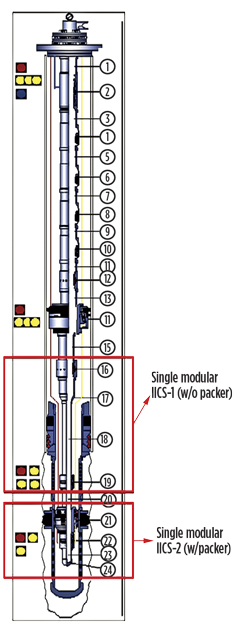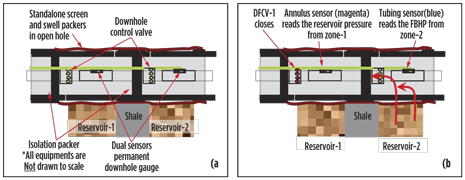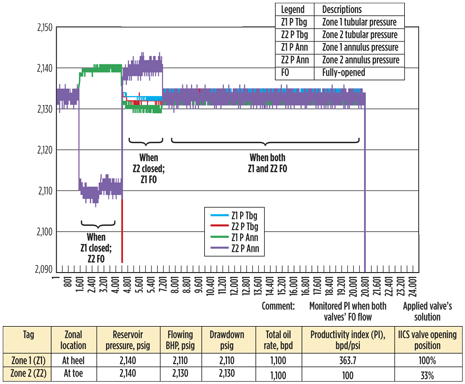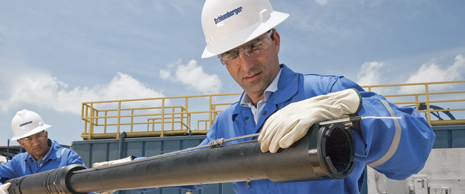J. H. CHRIS CHEN, N. M. AZRUL, B. M. FARRIS, K. Z. NURHAZRINA, M. K. M. AMINUDDIN and M. Y. SAIFUL ANUAR, PETRONAS Carigali; K. F. GORDON GOH, K. S. PREMJIT KAUR, T. K. DARREN LUKE and A. EDDEP, Schlumberger
An unfavorable zonal production split in a complex, highly dipping, multi-layered sandstone reservoir in a field offshore east Malaysia, was expected to cause premature water/gas breakthrough and, sometimes, even internal crossflow. An intelligent solution was recommended, since that would also address the issue of future selectivity being enabled by surface-controllable downhole valves upon flow regimes changing over time. Such zonal production control would delay water/gas breakthrough, and then react against water/gas encroachment. The IntelliZone Compact modular multi-zonal management system met all the requirements of cost-effectiveness and a fit-for-purpose deployment.
Solution for thin oil rim field. Since horizontal wells are among the most productive development options, the field development team decided to drill 14 horizontal wells initially. This decision significantly reduced the number of wells and maximized reservoir drainage points, greatly improving project economics.
However, stand-alone horizontal wells cannot assure optimum performance of inflow distribution throughout the entire horizontal length. To address possible unswept and bypassed oil in the less productive units, a downhole, active, flow control solution application in horizontal wells was one of the strategies selected to complete these complicated geologic structures while enabling zonal contribution adjustment and future zonal selectivity.
The decision to use intelligent zonal management was an alternative to the passive version of the inflow control device (ICD) applications. Out of eight commingling producers analyzed, two oil producers were selected as potential candidates for intelligent completion design.
New system deployment. Traditionally, an intelligently controlled completion system is designed with multi-position, downhole flow control valves (more than six intermediate positions) and surface flowrate measurements. The effort to control zonal water/gas cut threshold limitation can be complex and very costly, depending on the extent of “intelligence” and human intervention required. However, in actual practice, no more than three intermediate valve-opening positions are commonly used. The low-tier, compact concept of an Integrated Intelligent Completion System (IICS) for completing Wells A-1 and A-2 features two intermediate plus on-and-off valve positions, with a permanent, real-time downhole pressure-and-temperature monitoring system. Proactive up-front reservoir engineering analysis is included in designing optimal valve-opening sizes and positions.
The completion assembly integrates various components of the intelligent completion design, including flow control valves, zonal isolation packers, permanent pressure-and-temperature sensors and absolute feedback of valve choke depth positioning—all into one assembly joint. This joint, measuring less than 30 ft, is delivered to the wellsite and designed into a single-string component, Fig. 1.
 |
| Fig. 1. In this application, the intelligent completion system is delivered as a single joint of less than 30 ft. |
|
The assembly comes pre-configured and pre-tested, with electronics pre-welded. This design accelerates final well commissioning at the rig site, achieving costs savings and completion installation optimization. In this field, rig-time savings per zone was as much as two-thirds of the conventional intelligent completion installation time, with zero nonproductive time (NPT). For example, in ‘S’ field, installation was completed in 8 hr per zone rather than the 24 hr per zone required for conventional systems. A rig-time savings of up to 32 hr was achieved per completed well.
The surface-adjustable, intelligent hydraulics system responds to variable choke positions, which can be manipulated throughout the well's lifetime. With the guidance of permanent downhole pressure-and-temperature monitoring, this mechanism can remedy zonal production by coping with future production/production profile changes, flow anomalies and internal crossflow.
The main purpose of a surface-controllable flow control valve is to enable control of inflow reservoir fluid at any time throughout the well’s production life. This benefit is often overlooked as a luxury rather than a reservoir surveillance necessity, especially for horizontal wells’ zonal production allocation. Retrieving reservoir pressures, in two different reservoirs in a single horizontal section, is almost impossible with conventional slicklined memory gauges. Further, it is a challenge to leave the downhole shut-in tool and horizontal well movement assistance tool for days to allow for a pressure buildup survey. However, this type of testing is easily carried out in the IICS zonal control, Fig. 2.
 |
| Fig. 2. Figures A and B show a series of downhole operations to capture zonal reservoir pressures without associated intervention risk or production deferment. |
|
Zonal flow control simulation, field modeling. Prior to project implementation, detailed geological and petrophysical properties for each well were not available from the history-matching model. Using two separate simulators, production scenarios for each well were studied, based on different reservoir deliverability and fluid production sensitivities calibrated upon offset field performance. Various production scenarios were forecast, along with detailed sandface analysis.
An Integrated field-modeling suite that provides material balance, nodal analysis and system performance analysis was used to compare the estimated ultimate recovery for the wells that have surface-controllable, downhole flow control valves. Two production forecast scenarios were studied: potential production gain and downhole water/gas shut-off.
IICS installation, observation and results. In ranking well candidates, based on the well production profile and dynamic reservoir/fluid property responses, like water cut and gas-oil ratio, all wells with potential for downhole flow control assembly installation were analyzed. Different sandface production sensitivities were performed: oil increment, water-cut reduction, gas-to-oil ratio profile and flowing bottomhole pressure. Highest-ranking candidates showed positive sandface analysis results for optimal downhole flow control installation against the base-case stand-alone screen installation.
From the zonal enabling IICS sensors, Zone 1 and Zone 2 PI contribution was tested to be at the ratio of 3:1 respectively, Fig. 3. As per the reservoir management plan, the asset team decided to revert to a balanced ratio of 1:1 zonal production allocation, which is enabled by the presence of the IICS zonal valves. The delta-pressure profiles demonstrated that Zone 2 had dominated the entire commingled production to the extent of production bypass or zero inflow from Zone 1. Hence, with the help of zonal active valves of the IICS, mitigation to revert to the balanced ratio of 1:1 zonal production allocation was achieved by adjusting the IICS zonal valves, accordingly, by surface hydraulic control. Overall, IICS was installed successfully in Well-A1 and has been in service for more than 1½ years. The flowlines for the first IICS well were completed in late September 2010, with a post-job production startup of 1,200-1,300 bopd and continual output at zero water/gas-cut production still in effect.
 |
| Fig. 3. Zone 1 and Zone 2 PI contribution was tested to have a ratio of 3:1. |
|
The installation of the IICS in Well-A2 was also successful. When one of the zones is shut, its annulus gauge pressure is allowed to build up until reservoir pressure is attained for Well A-1. In the meantime, the other zone valve is at fully opened inflow position, where the annulus pressure gauge is allowed to register drawdown, and thus PI, for that particular zone individually. This is in reference to the zonal inflow control logics previously described in Figure 2 for zonal analysis.
Coupled with the pressure buildup survey, zonal flowing bottomhole pressure and surface well test results, productivity and zonal reservoir deliverability were studied to provide invaluable information to understand the reservoirs better. Seven flow control valve configurations were studied, Table 1.
| Table 1. Well A-2 flow control valve configurations. (Click to enlarge) |
|

|
In Case 0, with both Zone 1 and Zone 2 at 100% opening, Well A-2 produces 1,179.21 blpd with 0.12% water cut and 0.176 MMscfd of gas. Cases 1 and 2 were studied to determine PI for Zone 1 and 2. It was observed from Case 2 that Zone 2 had higher PI and was the dominant contributor, with 1,067.60 blpd, 4.80% water cut and 0.07767 MMscfgd. This indicated that, due to low PI, Zone 1 did not contribute any production in Case 0.
After several configurations were evaluated, the asset team decided that Case 3 with 33% opening position in Zone 1 and 100% opening in Zone 2 was the optimum configuration. This configuration produces 1,144.40 blpd with 0.22% water cut and 0.190 MMscfd of gas.
The second IICS well was installed in February 2011. The post-installation production trend of the two-zone intelligent well control has been encouraging, with Well A-1 producing about 1,600-1,700 bopd, net oil, while Well A-2 is at 1,100-1,200 bopd, net oil, on average.
IICS enables production gain. Compact, cost-effective and modular, new IICS well technology has now been successfully deployed offshore eastern Malaysia. This is in multi-stacked reservoirs having an overall 40-m-thick oil column with marginal oil-in-place, along with a large gas cap. Both IICS wells are producing at zero water/gas-cut to date, defying predictions of gas breakthrough within the first few months, based on field simulations under the base-case of no downhole flow control. 
ACKNOWLEDGMENT
The authors would like to thank the project team of PETRONAS Carigali and its new Smart Well Team for the collaboration and full support to make this article possible, and for granting permission to release appropriate data. We would also like to thank all parties involved in making implementation of these two pioneer intelligent wells a success for Petronas.
|
AUTHORS
|
| CHRIS CHEN, previously with Petronas Carigali, recently joined Shell Todd Oil Services in New Plymouth, New Zealand, as a surveillance production technologist. Previously he was the senior production technologist, responsible for the asset team in designing and executing the well completion job, and monitoring the production from the well itself. Mr. Chen obtained his Bachelors degree in mechanical engineering from Universiti Teknologi Petronas in 2004. He has seven years of various production technology and completion experience, in offshore and onshore wells. |
|
| MO MOHD AZRUL NURIYAD is a senior production technologist for Petronas Carigali Sdn Bhd (PCSB), and is assigned to international projects. He earned a Bachelors degree in petroleum engineering from UTM, Malaysia, in 2003 and worked with several companies before joining PCSB in 2005. He works in field development projects, well surveillance and production enhancement activities. |
|
| M. FARRIS BAKAR is a completion engineer for Petronas Carigali Sdn Bhd. He is the senior completion engineer who designed the detailed completion engineering and is involved in pre-drilled intelligent completions evaluation/screening and execution of Sumandak Smart Well. He previously worked with the Kinabalu team for the 10K drilling campaign and execution, and was concurrently involved in the completion design for HPHT wells. Mr. Bakar earned his degree in mechanical engineering while majoring in petroleum engineering. He graduated from University Technology Petronas, Tronoh, Malaysia, in 2005. He has been with Petronas Carigali for six years and has been part of the Completions Engineering Department since 2006. |
|
| NUR HAZRINA is currently serving Petronas Carigali Malaysia. She is the Production Technologist in-charge for surveillance and optimization of the intelligent completions. Nur Hazrina obtained her Bsc in Chemical Engineering from Universiti Teknologi Petronas, in 2007. Since then, she has worked for Petronas Carigali for five years. |
|
| MOHD AMINUDDIN is the head of Resource Studies for Petronas Carigali Vietnam Limited. He manages the resource studies team for Vietnam under the interest of Petronas Carigali Overseas. He started working as a workover engineer and production technologist in 2006. Later, he joined the Well Testing team as a senior well testing engineer. While in his current position, he has designed intelligent completions, sand control and artificial lift, and has also been the focal point for HPHT and tight gas well testing and completions. Mr. Aminuddin obtained his Bachelor of Engineering (Hons.), mechanical engineering, from Petronas University, Malaysia, in 2006. He has been with Petronas since 2006. |
|
| SAIFUL ANUAR works for Petronas Carigali Sdn Bhd as a senior reservoir engineer with one of the asset teams in the Resource Management Department. His main task is to manage an oil field in the Sabah area that is produced through horizontal and deviated wells equipped with water-injection support as a reservoir surveillance engineer. Mr. Anuar obtained his BSc degree in petroleum engineering from Universiti Teknologi Malaysia in 2005 and has been with Petronas Carigali since 2005. |
|
| GORDON GOH is the Schlumberger Completions Domain champion in the East Asia GeoMarket (EAG). He is the senior reservoir engineer assisting the asset team in pre-drilled, intelligent completions evaluation/screening, reservoir modeling and valve-sizing optimization. He later worked with the production team on the post-installation zonal inflow control to optimize production in these intelligent completions. Mr. Goh obtained his MSc degree in petroleum Engineering from Heriot-Watt University, Edinburgh, UK, in 2007. He previously earned his BSc degree in chemical engineering during 2002. He has been with Schlumberger for more than 10 years and has been part of Schlumberger Completions since 2007. |
|
| PREMJIT KAUR KAKA SINGH is the Schlumberger Completions technical engineer for the East Asia GeoMarket, working mainly on permanent downhole monitoring and intelligent completions. She graduated with a Masters degree in petroleum geology from the University of Malaya (UM), Malaysia, and has been part of Schlumberger Completions since 2008. |
|
| DARREN TECK KOON LUKE is a Schlumberger Completions supervisor, based in Angola. He joined Schlumberger in 2004 after graduating from the University of Manchester Institute of Science and Technology, UK, with a Bachelors degree in chemical engineering. Mr. Luke has considerable offshore, sales and marketing experience in deepwater, permanent, downhole monitoring installations and intelligent completions. |
|
| EDDEP AHMAD is a Schlumberger Completions technical engineer, based in Malaysia. He graduated in 2005 with a Bachelors degree in electronic and electrical engineering from Leeds Metropolitan University, UK. Mr. Ahmad joined Schlumberger in 2006 and has extensive offshore installation experience, especially in deepwater completions, permanent downhole monitoring, fiber optics and intelligent completions. |
|
|






